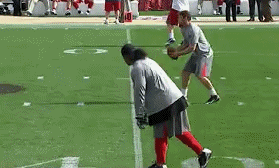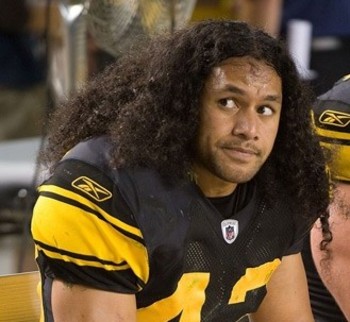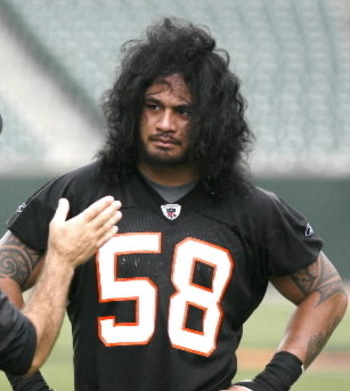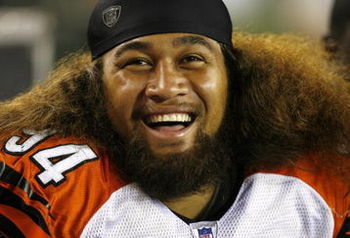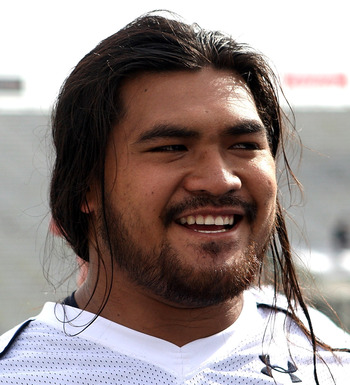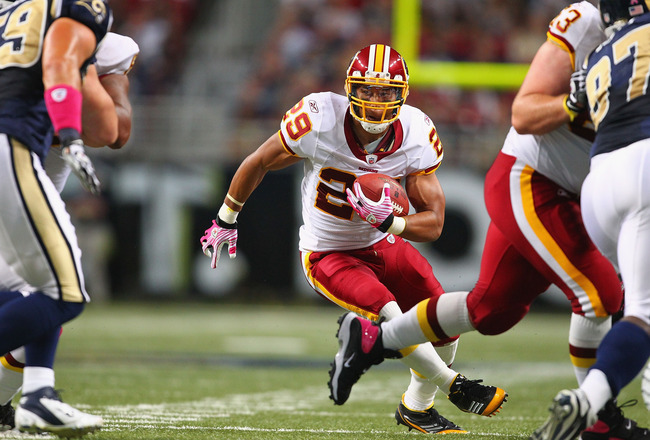The One stop to find out about Polynesians in sports at the amateur, high school, collegiate and professional levels and much more.
Monday, November 14, 2011
ANIMATED: San Francisco 49ers NT Isaac Sopoaga Will Blow Your Mind
by Bill Hanstock • Nov 14, 2011 8:00 AM PST
The San Francisco 49ers picked up another big victory on Sunday over the New York Giants, but some startling new information has come to light during the pre-game warmups. I'm no scientist, but I think we've uncovered photographic evidence that the Niners just may -- just may -- be creating some sort of superhuman contingent.
via assets.sbnation.com
What you're looking at in the above .gif is San Francisco 49ers nose tackle Isaac Sopoaga. He is 6'2" and weighs 330 pounds. A couple of weeks ago, this fellow grabbed a crucial pass on a game-clinching drive. Now that I'm looking at this new evidence that is in no way sped up or altered, I can only make one, obvious conclusion: the 49ers are involved in genetic tampering.
Let the record further show that Sopoaga, a former rugby player, occasionally shows off his strong arm during pre-game warm-ups by firing passes around the field to his teammates.
Now, I'm not sure whether we're talking about rays of the gamma or cosmic variety. I have no clue as to whether the San Francisco team geneticists are using radiation, or mystical crystals, or possibly Terrigen Mists. Perhaps it's just good old-fashioned super soldier serum. But whatever they're tampering with over there, it's clearly working. The 49ers, against all odds, hold an 8-1 record and their massive nose tackle is darting around the field like Usain Bolt.
Keep it up, you beautiful mad scientists. Whatever you're doing in the basements of Candlestick Park, it's working.
Thursday, November 10, 2011
Monday, November 7, 2011
Roy Helu: Can He Keep the Starting Job for the Washington Redskins?
I don't think anyone would argue that it is hard holding down a job in this economy. The current 9.1 percent national unemployment rate speaks for itself.
But the NFL is a different story when it comes to joblessness. Unless you play for Mike Shanahan, that is.
In fact, I bet any player donning a Washington Redskins jersey right now might think their chances of keeping a job on Main Street are better than doing so for Shanahan (just ask Ryan Torain, Rex Grossman or Anthony Armstrong).
So this begs an important question: Now that Roy Helu has been awarded Washington's starting running back job, will he keep it?
Now I'm no economist, but Helu's ability to keep the starting job is one that I think is fairly predictable, as the indicators pointing to his potential success are apparent. Those important indicators are his year-to-date performance, his competition in the backfield and that ever-escaping Mike Shanahan "Stamp of Approval."
In terms of Helu's performance so far this year, I don't think there is any question that he is deserving of the starting gig. After the game on Sunday, Helu is now the 12th-most targeted running back in the NFL this season and has caught the 12th-most passes.
To add to that, he is sporting a respectable 4.6 yards per rush in his rookie year, and if you only count games where he's had eight or more carries, his average jumps to 5.4 (which would be good for a tie for fourth amongst starting NFL running backs at this point). Helu's blitz pickup skills are also rapidly improving, which makes him a pretty good all-around back—good enough to start in the NFL, as he showed on Sunday.
As far as competition goes, there isn't much. Ryan Torain has averaged an embarrassing 1.6 yards per rush in his last four games, and found himself in Mike Shanahan's doghouse against the 49ers.
Recent pickup Tashard Choice isn't much better, already disappointing Dallas so much this year that he was waived midseason. Add to that the fact that Choice is nursing a hamstring injury, and Helu should have a fairly easy time looking like the best back to go with week in and week out.
Mike Shanahan's stamp of approval is probably the most important piece of this puzzle, however, especially in the minds of fantasy owners. This is where it becomes tricky, because Shanny is known for being extremely unpredictable—something fantasy owners hate.
Well, if Shanahan's words after Helu's 149-total-yard performance were any indication, I'd say the rookie back could be a fantasy steal for the rest of the season. The age-old coach praised Helu, saying "he's got the speed to make some big plays" and "he's a pretty good all-around back."
Shanahan also mentioned that Torain will now only see the field when Helu is "tired." Given the load Helu carried the whole game Sunday without looking worse for the wear, I'd say Shanahan has full confidence in the young back to play through every game going forward.
Now Shanahan's sentiment could always change, but given Helu's talent level and hunger to win the starting role for good, I think he's easily worth a shot.
So if you've been holding onto Helu, you might have just hit the fantasy jackpot. Especially if you play in a PPR league, where Helu's value is immense (14 catches against the 49ers). If he's still available on the waiver wire, make him your top target this week.
And while Washington's run schedule is not very easy the next three weeks (MIA, DAL and SEA), it looks like a fantasy owner's dream during the playoff run from Week 13 through Week 16. During that time, the Redskins face the Jets, Patriots, Giants and Vikings—all which rank in the bottom half in the NFL in terms of fantasy points allowed to running backs (standard leagues).
That means Helu could very well be the difference in your fantasy team going all the way this year. So grab him fast. And while the rest of your league says "goodbye," you will say "Helu" to a fantasy championship.
But the NFL is a different story when it comes to joblessness. Unless you play for Mike Shanahan, that is.
In fact, I bet any player donning a Washington Redskins jersey right now might think their chances of keeping a job on Main Street are better than doing so for Shanahan (just ask Ryan Torain, Rex Grossman or Anthony Armstrong).
So this begs an important question: Now that Roy Helu has been awarded Washington's starting running back job, will he keep it?
Now I'm no economist, but Helu's ability to keep the starting job is one that I think is fairly predictable, as the indicators pointing to his potential success are apparent. Those important indicators are his year-to-date performance, his competition in the backfield and that ever-escaping Mike Shanahan "Stamp of Approval."
In terms of Helu's performance so far this year, I don't think there is any question that he is deserving of the starting gig. After the game on Sunday, Helu is now the 12th-most targeted running back in the NFL this season and has caught the 12th-most passes.
To add to that, he is sporting a respectable 4.6 yards per rush in his rookie year, and if you only count games where he's had eight or more carries, his average jumps to 5.4 (which would be good for a tie for fourth amongst starting NFL running backs at this point). Helu's blitz pickup skills are also rapidly improving, which makes him a pretty good all-around back—good enough to start in the NFL, as he showed on Sunday.
As far as competition goes, there isn't much. Ryan Torain has averaged an embarrassing 1.6 yards per rush in his last four games, and found himself in Mike Shanahan's doghouse against the 49ers.
Recent pickup Tashard Choice isn't much better, already disappointing Dallas so much this year that he was waived midseason. Add to that the fact that Choice is nursing a hamstring injury, and Helu should have a fairly easy time looking like the best back to go with week in and week out.
Mike Shanahan's stamp of approval is probably the most important piece of this puzzle, however, especially in the minds of fantasy owners. This is where it becomes tricky, because Shanny is known for being extremely unpredictable—something fantasy owners hate.
Well, if Shanahan's words after Helu's 149-total-yard performance were any indication, I'd say the rookie back could be a fantasy steal for the rest of the season. The age-old coach praised Helu, saying "he's got the speed to make some big plays" and "he's a pretty good all-around back."
Shanahan also mentioned that Torain will now only see the field when Helu is "tired." Given the load Helu carried the whole game Sunday without looking worse for the wear, I'd say Shanahan has full confidence in the young back to play through every game going forward.
Now Shanahan's sentiment could always change, but given Helu's talent level and hunger to win the starting role for good, I think he's easily worth a shot.
So if you've been holding onto Helu, you might have just hit the fantasy jackpot. Especially if you play in a PPR league, where Helu's value is immense (14 catches against the 49ers). If he's still available on the waiver wire, make him your top target this week.
And while Washington's run schedule is not very easy the next three weeks (MIA, DAL and SEA), it looks like a fantasy owner's dream during the playoff run from Week 13 through Week 16. During that time, the Redskins face the Jets, Patriots, Giants and Vikings—all which rank in the bottom half in the NFL in terms of fantasy points allowed to running backs (standard leagues).
That means Helu could very well be the difference in your fantasy team going all the way this year. So grab him fast. And while the rest of your league says "goodbye," you will say "Helu" to a fantasy championship.
The NFL's All-Hair Team: The 22 Wackiest Hairstyles in the League
Safety Troy Polamalu
No, that is not a picture of Polamalu's epic Head and Shoulders commercial. Instead, it is him siting on the sideline at a game earlier this season.
By now we all understand that hair is alive, this is why it grow, so it shouldn't come as much of a surprise that Troy's hair continues to grow and will soon own enough territory to gain independence from the United States.
If you have been reading throughout this article and were waiting for an epic Troy Polamalu slide, you can forget about it. Everything that needs to be said or thought is in the picture.
No, that is not a picture of Polamalu's epic Head and Shoulders commercial. Instead, it is him siting on the sideline at a game earlier this season.
By now we all understand that hair is alive, this is why it grow, so it shouldn't come as much of a surprise that Troy's hair continues to grow and will soon own enough territory to gain independence from the United States.
If you have been reading throughout this article and were waiting for an epic Troy Polamalu slide, you can forget about it. Everything that needs to be said or thought is in the picture.
The NFL's All-Hair Team: The 22 Wackiest Hairstyles in the League
LB Ray Maualuga
Now, someone is having a bad hair day here. It looks as if Ray Ray's locks came alive and attempted to blind him. There are so many puns that I could use here, but I will just stick with the obvious one.
Hair's "Age of Aquarius" ladies and gentlemen.
Now, someone is having a bad hair day here. It looks as if Ray Ray's locks came alive and attempted to blind him. There are so many puns that I could use here, but I will just stick with the obvious one.
Hair's "Age of Aquarius" ladies and gentlemen.
The NFL's All-Hair Team: The 22 Wackiest Hairstyles in the League
DL Paul Soliai
Many people had never heard of Soliai when he came out of nowhere last season to become one of the best nose tackles in the NFL, a performance that earned him a franchise tag tender and huge annual contract.
I would have to conclude that Miami fans now know this huge example of a human being well enough to know that he isn't going to eat your children when walking past the small yellow school bus on a November afternoon.
They can relax.
Many people had never heard of Soliai when he came out of nowhere last season to become one of the best nose tackles in the NFL, a performance that earned him a franchise tag tender and huge annual contract.
I would have to conclude that Miami fans now know this huge example of a human being well enough to know that he isn't going to eat your children when walking past the small yellow school bus on a November afternoon.
They can relax.
The NFL's All-Hair Team: The 22 Wackiest Hairstyles in the League
DL Isaac Sopoaga
"Soap," as he is called in San Francisco, is someone that I wouldn't want to see walking down the street late at night in a fit of rage. The do-rag here also lends some credence to that intimidating physique that anchors the league's No. 1 rush defense.
Sopoaga is another player on this list from American Samoa, which leads me to believe they represent the demographics of the male citizens there.
"Soap," as he is called in San Francisco, is someone that I wouldn't want to see walking down the street late at night in a fit of rage. The do-rag here also lends some credence to that intimidating physique that anchors the league's No. 1 rush defense.
Sopoaga is another player on this list from American Samoa, which leads me to believe they represent the demographics of the male citizens there.
The NFL's All-Hair Team: The 22 Wackiest Hairstyles in the League
DL Domato Peko
If this were a Brillo hair pageant we would have a winner. Peko's style reminds me of Phil Spector meets Emmett Brown from Back to the Future.
If this were a Brillo hair pageant we would have a winner. Peko's style reminds me of Phil Spector meets Emmett Brown from Back to the Future.
The NFL's All-Hair Team: The 22 Wackiest Hairstyles in the League
OL Mike Iupati
It it just me or does Mike Iupati look like the son of former San Francisco 49ers offensive lineman Jesse Sapolu? If you need a refresher, check this out. The similarities don't end with looks, they are both from America Samoa and have incredible mean streaks in them.
49ers fans can just hope that Iupati's career ends up as good, if not better, than Sapolu's.
It it just me or does Mike Iupati look like the son of former San Francisco 49ers offensive lineman Jesse Sapolu? If you need a refresher, check this out. The similarities don't end with looks, they are both from America Samoa and have incredible mean streaks in them.
49ers fans can just hope that Iupati's career ends up as good, if not better, than Sapolu's.
The NFL's All-Hair Team: The 22 Wackiest Hairstyles in the League
OL Chris Kemoeatu
Anyone remember Manumana, the long snapper on the great football movie Necessary Roughness? If you don't, check out this clip of him walking in on a young Kathy Ireland.
I bring this up because Kemoeatu is a spitting image of the actor that snapped balls to Scott Bakula, saw Ireland naked and viewed Sinbad's amazing failure at acting.
Still, I don't think he would have been anywhere as nice to the long-legged beauty as the real Manumana was.
Anyone remember Manumana, the long snapper on the great football movie Necessary Roughness? If you don't, check out this clip of him walking in on a young Kathy Ireland.
I bring this up because Kemoeatu is a spitting image of the actor that snapped balls to Scott Bakula, saw Ireland naked and viewed Sinbad's amazing failure at acting.
Still, I don't think he would have been anywhere as nice to the long-legged beauty as the real Manumana was.
Louisville's Peyton Siva knows his place
Calling Peyton Siva the most important player on a University of Louisville men’s basketball team that also has Kyle Kuric and Gorgui Dieng could make for talk-radio and message-board arguments.
What can’t be debated is that Siva presents a luxury coach Rick Pitino hadn’t previously had during his tenure at U of L. Reece Gaines, Taquan Dean, Brandon Jenkins, Andre McGee and Edgar Sosa all had different strengths, but none could be called a pure point guard.
“The thing that we bring to the table is something unique,” Siva said.
“Mine is distributing the ball and moving it around so hopefully everybody contributes and everybody will play a big role this year.”
Siva’s 5.2-assist average last season was the fifth highest in school history. Only Phil Bond (1975-76 and ’76-77) and LaBradford Smith (1988-89 and ’89-90) have produced higher numbers. Siva’s 182 assists were the fourth-highest season total.
McGee, now on Pitino’s staff as a program assistant, predicts Siva’s assist numbers will rise this season.
“He’s starting to understand and realize what makes him look good,” McGee said. “He’s starting to take that role as (Boston Celtics guard Rajon) Rondo kind of has: knowing that he’s the engine behind everybody getting off.”
That Siva grew into the role last season was a byproduct of inheriting the starting job from Sosa. Siva, who also averaged 9.9 points and 3.1 rebounds, endured the difficult process of figuring out how Pitino wanted his offense run and learning to implement it.
Senior Chris Smith witnessed Siva’s struggles as a freshman. The same plays Siva was used to making in high school with superior athleticism no longer were available in college.
“He was turning the ball over in practice like crazy,” Smith said.
“Coach said he set the record.”
Siva’s speed allowed him to penetrate with ease, but once he got past the initial defender he’d be stuck in the lane with nowhere to go with the ball. It led to a lot of ill-advised passes and shots.
McGee said Siva’s early problems were typical of point guards coming into Pitino’s system. As a freshman his 46 turnovers nearly matched his 56 assists. That’s part of what prevented Siva, who was Washington’s 2009 Mr. Basketball and a McDonald’s All American, from beating out Sosa for the starting job.
“That’s what he most had issues with. He’s never been in a predicament where he had to sit there and watch or play behind anyone his whole career playing basketball,” said Daryll Hennings, Siva’s AAU coach.
“He’d never been through that, so that was kind of a learning process for him that was a good thing.”
When Siva first played on Hennings’ Seattle Rotary Select team, he developed a reputation for not knowing how to channel his competitive rage. It often led him to cry from anger on the court and mouth off to officials.
He took the rigors of his first year at U of L as a challenge to get better.
“My freshman year was hard,” Siva said.
“I felt like, why would I even be here at Louisville? At the end of that year I knew I really had to clamp down and learn the game of basketball if I wanted to play.”
The biggest adjustment was learning to control his speed. He used to know only one level, which is why he ended up committing so many turnovers and getting into foul trouble.
“He’s so fast at times it can hurt him being out of control,” McGee said. “That’s one thing especially from back then to now he’s really changed a lot. He’s not out of control; he uses gears. Nobody in the country has the foot speed that can keep up with him.”
No other series typified Siva’s improvement than the Cardinals’ three games against eventual national champion Connecticut last season.
s
That’s why Pitino has told some recruits that Siva could skip his senior season and become a first-round NBA draft pick.
“We think he’s one of the premier point guards in the country,” Pitino said.
“He had a lot of turnovers his freshman year. Now he’s playing fast, but he’s not turning it over.”
Pitino said whichever team he places Siva on in practice doesn’t lose. Siva proved that in the Cardinals’ two public intrasquad scrimmages.
Siva’s development has been obvious to his teammates. Smith said the best is yet to come.
“This summer playing with Siva was like, wow, we have a true point guard and a true leader now,” he said.
Roy Helu: 5 Interesting Facts About Washington Redskins RB
By Hal Nichols (Contributor) on November 6, 2011
Rookie running back Roy Helu Jr. is a virtual unknown outside of the middle of the country, where he made his impact playing for the University of Nebraska. Today, he looks poised to become the latest semi-anonymous running back to burst onto the scene behind Mike Shanahan’s zone blocking scheme. Here are five things you probably didn’t know about Roy Helu Jr.
Helu’s family is from Tonga, a tiny nation of islands in the South Pacific of just over 100,000 people. Tonga lies just to the southwest of American Samoa, the hotbed of NFL talent to which the likes of Troy Polamalu and Junior Seau trace their lineage.
In college, Helu logged five yards per carry or more in each of his three final seasons at Nebraska, and better than six yards per carry as a sophomore and as a senior. This is especially impressive considering Helu was primarily used between the tackles. He showcased the ability to run over larger defenders and run away from the faster, smaller ones.
Helu also showed impressive versatility at Nebraska, running from all imaginable formations, including the pistol, and executing both conventional running plays as well as zone read and option plays. All of that experience in different looks and schemes should be an asset in the NFL, as he should have little trouble picking up new schemes.
At the combine, Helu was one of the most impressive performers at his position, logging a 4.42 forty yard dash at 220 pounds. That combination of size and speed make Helu an ideal back for Shanahan’s zone blocking scheme, which rewards running backs who can find the hole and then explode through it. Helu isn’t quite six feet tall either, so his compact size is built to run with power.
Helu is perfect for Shanahan’s running scheme. Helu’s combine report from NFL.com reads,
“Does a good job running behind his blockers and finding running creases. Has more straight-lined speed than most big backs. Can get the edge, stick his foot in the dirt and accelerate upfield.”
Almost word for word, that’s the textbook description of a successful running back in Shanahan’s system.
Roy Helu Jr. should be in for some nice outings in the second half of this season. If history serves as any indication, under Shanahan’s coaching, Helu likely won’t be an unknown by year’s end.
High-school scrapper and late-blooming pro Wayne Hunter begins to put it all together
By Greg Hanlon
5:52 pm Nov. 7, 2011
Each time the Jets or Giants play a football game, Capital will write about a home-team member who took part in it. This post is about Wayne Hunter, who played offensive tackle in the Jets’ 27-11 win on Nov. 6 over the Buffalo Bills.
Football people often talk about how the benefits of the running game can’t always be captured through conventional statistics. Such was the case yesterday, when the Jets averaged an unimpressive 3.6 yards on their 35 designed running plays against the Buffalo Bills, yet largely have the running game to thank for their overall impressive offensive performance.
Consider that quarterback Mark Sanchez posted his best completion percentage of the year yesterday, hitting on 20 of his 28 passes. According to the ESPN Stats & Information Group, Sanchez’s numbers were heavily bolstered by plays involving a faked running play, on which Sanchez hit on 11 of his 12 passes for 129 yards and his only touchdown.
The Jets lined up a fullback nearly 60 percent of the time yesterday, compared to a season average of 32 percent before yesterday, according to ESPN. Also, the Jets' lopsided advantage in time of possession—they had the ball for nearly 38 minutes—was largely attributable to a running game that kept their offense “on schedule” and kept Buffalo’s explosive offense off the field.
Thus, despite the Jets’ pedestrian rushing totals, reports of the triumphant return of “ground and pound”—the offensive philosophy that emphasizes a punishing, bread-and-butter running game over passing pyrotechnics, reflecting the swaggering machismo of Rex Ryan’s team—are well-founded.
If you’ve been following the Jets this year, you probably know the storyline: Wanting to expand the role of quarterback Mark Sanchez and having acquired Plaxico Burress to round out a talented group of receivers, the Jets changed their offensive approach at the beginning of the year and started passing more. It didn’t work, and now they’re back to doing what they do best.
“I think I was kind of set up and enamored with those three-wides and, when we looked at it, we said that might suit our personnel better,” Ryan told reporters during the Jets bye week before the Buffalo game.
“But what’s really best for the Jets is the ability to run the football, maybe play more regular personnel [groupings] and two-tight end personnel groupings,” he said.
Along with the change in the type of formations they’re using has been a change in their blocking schemes, according to Damien Woody, the former Jets standout offensive lineman who now works as an analyst for ESPN. (Woody was considered one of the Jets best run-blockers, but he was cut for salary-cap reasons and decided to retire rather than come back at a reduced price.)
Woody told me that from 2009 to 2010, the Jets running game had evolved include more zone-blocking schemes, rather than man-blocking. In man-blocking, each lineman is responsible for blocking an individual player. In zone-blocking, the line moves as a unit as if on a moving chain, and each lineman is responsible for blocking any defender who attempts to breach that chain.
That trend continued in the early part of this year, but with poor results.
“Sometimes, you incorporate different schemes early on in the year and things don’t mesh as well," he told me. "It came to the point where they were running a lot of zone-blocking schemes when you’re moving more east-west than north-south.
“But now, when I saw the San Diego game, it was more of a man-blocking scheme, more just firing off the ball and going mano-a-mano, or combo blocks. It’s a matter of scouting yourself and seeing, ‘Here’s what we do best, let’s focus on it, and let’s get back to it.’”
STILL, SCHEMES DON'T MATTER MUCH if the players aren't playing well. Which brings us to Wayne Hunter, the Jets’ 30-year-old right tackle, who is a starter in the league for the first time in his eight-year NFL career.
Hunter’s season got off to a disastrous start in Week 1 against Dallas. Rob Ryan, the Cowboys defensive coordinator and Rex’s Lebowski-ish twin brother, intentionally isolated superstar linebacker DeMarcus Ware on Hunter. Hunter didn’t handle it well, allowing one sack and six quarterback pressures while being publicly pitied on national television by NBC analyst Cris Collinsworth.
“I think it was a good challenge,” Hunter told reporters afterward. “It’s all upside from here.”
But things got worse before they got better. Hunter followed that up with two more poor games. According to Pro Football Focus, which grades every player after every game, Hunter was nearly off-the-charts-bad in those first three games. It was clear: The Jets offense didn’t resemble the physical unit of the previous two seasons, and the new right tackle seemed to be a big reason why.
But quietly, Hunter shook off his poor start. According to Pro Football Focus, each of the four games he played going into Sunday since those ghastly first three were above average. He even had his redemption in a nationally televised game when he stonewalled the Dolphins' Pro Bowler Cameron Wake in one-on-one protection, earning praise from the television analysts.
The Jets running game began to round into form too, showing signs of life against New England and Miami before producing 162 rushing yards on Oct. 23 against San Diego. That game, plus yesterday’s 126-yard output (in net yards, including Mark Sanchez scrambles and sacks), represented the only time the Jets rushed for more yards than the league average of 115.
Yesterday, Hunter allowed an early sack to Buffalo’s Alex Carrington. On the play, it looked like Hunter was late getting off the snap because he was confused about the count. Later in the game, Hunter committed a false-start penalty, also because he didn’t know the snap count.
Those were the plays visible to the casual viewer. If you watched Hunter carefully, though, you would have seen that he executed his job an overwhelmingly high percentage of the time and played outstandingly, both in run-blocking and pass-protection. He was part of a Jets effort that controlled the line of scrimmage so thoroughly that it’s surprising the Jets didn’t blow the game open much earlier than they did.
IF HUNTER IS RE-WRITING THE STORY OF HIS SEASON, THE SAME applies to his career, which began about as dismally as possible. Hunter was a third-round draft pick by the Seattle Seahawks in 2003, but didn’t make a smooth adjustment to the pro game and played in just two games in three years.
All the headlines he made were off the field. During his time in Seattle, he was arrested twice, once for domestic violence and once for a bar fight. The Seahawks released him and Hunter was picked up by the Jacksonville Jaguars, but he didn’t do much with his second chance. He failed to make the team in training camp of 2006, and then he missed all of 2007 with a knee injury.
It seemed like a bitter end to football life that Hunter was drawn into by his circumstances, when Kelly Sur, head coach at Radford High School in Hawaii, heard about the lanky freshman with a reputation for fisticuffs. The kid had spent much of his childhood in a single-family home the projects in the rough Kalihi section of Honolulu. His mother, a New Zealand native of Samoan heritage, had worked multiple jobs to move her family to a better neighborhood. But Hunter brought the quick-to-violence mentality of Kalihi to his new school.
“He wasn’t a troublemaker, but he wouldn’t back down,” Sur remembered of Hunter, who, like so many NFL players, considered himself a basketball player in his youth.
“I approached him and said, ‘You’re a quiet guy, but I know you’re not afraid to rough it up. Why don’t you come out for football? You can rough up anyone out here and not get into trouble.’”
Hunter excelled on the field and in the classroom. He started his college career at UC-Berkeley, then transferred to Hawaii.
But it was all set for a disappointing ending before the Jets took a flyer on him before the 2008 season. They saw his athleticism and potential for growth, even at an advanced age. When the Jets cut Woody and Woody subsequently retired, they handed the job to Hunter.
“I’m proud of his progress,” Woody told me. “Wayne was a high draft pick but things didn’t work out. We came to the Jets the same year, and Wayne kinda resurrected his career. And now look at him: He’s starting. Wayne’s a late bloomer. He always had those athletic skills, and now he’s putting it all together.”
Subscribe to:
Posts (Atom)
